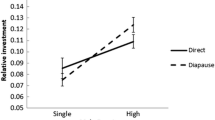Abstract
We model the optimal copulation duration in the yellow dungflyScathophaga stercoraria, assuming that males optimize their reproductive success per day. The independent state-variables of a male are the actual sperm reserves, the female encounterrate and the time of the day. We used stochastic dynamic programming to predict the optimal copulation duration. The model predicts that copulation duration should increase (i) for larger males, (ii) for males with a better previous diet (iii) for males accepting more females (iv) for males staying away from the dung during a whole day. It also predicts that (v) males on a restricted diet should accept fewer matings, (vi) testes size should shrivel during the day, (vii) the correlation coefficient between copulation duration and sequence number should decrease with increasing initial sperm reserve and with increasing number of copulations performed on a given day.
There are two essential differences between our model and a model of Parker (1992). (i) Our model assumes that males optimize per day. Parker's model assumes that males optimize per mating bout, one bout comprising many days. (ii) Since all the important state variables depend only on the moment of the copulation, our model does not assume a long-time memory in dungflies, and it is more flexible than Parker's model. Overall, both models explain the data available equally well.
Similar content being viewed by others
References
Borgia, G. (1981). Mate selection in the flyScatophaga stercoraria: female choice in a male-controlled system. Anim Behav 29: 71–80.
Mangel, M. and C.W. Clark (1988). Dynamic Modelling in Behavioral Ecology. Princeton NJ, Princeton University Press.
Nuyts, E. and N.K. Michiels (1993). Integration of immediate and long term sperm precedence patterns and mating costs in an optimization model of insect copulation duration. J. theor. Biol. 160: 271–295.
Parker, G.A. (1970a). Sperm competition and its evolutionary effect on copula duration in the flyScatophaga stercoraria. J. Insect Physiol 16: 1301–1328.
Parker, G.A. (1970b). The reproductive behaviour and the nature of sexual selection inScatophaga stercoraria L. (Diptera: Scatophagidae). I. Diurnal and seasonal changes of population density around the site of mating and oviposition. J Anim Ecol 39: 185–204.
Parker, G.A. (1970c). The reproductive behaviour and the nature of sexual selection inScatophaga stercoraria L. (Diptera: Scatophagidae). II. The fertilization rate and the spatial and temporal relationships of each sex around the site of mating and oviposition. J Anim Ecol 39: 205–228.
Parker, G.A. (1978). Searching for mates. In: J. Krebs and N. Davies, eds., Behavioural Ecology: An Evolutionary Approach, pp. 214–244. Sunderland, Mass Sinauer.
Parker, G.A. (1992). Marginal value theorem with exploitation time costs: diet, sperm reserves, and optimal copula duration in dung flies. Am. Nat. 139: 1237–1256.
Parker, G.A., L.W. Simmons and H. Kirk (1990). Analysing sperm competition dat: simple models for predicting mechanisms. Behav Ecol Sociobiol 27: 55–65.
Parker, G.A. and L.W. Simmons (1991). A model of constant random sperm displacement during mating: evidence fromScatophaga. Proc. R. Soc. Lond. B 246: 107–115.
Parker, G.A. and R.A. Stuart (1976). Animal behaviour as a strategy optimizer: evolution of resource assessment strategies and optimal emigration thresholds. Amer. Nat. 110: 1055–1076.
Sigurjònsdòttir, H. (1980). Evolutionary studies of sexual dimorphism in size: studies on dung flies and three groups of birds. Unpublished Ph. thesis, University of Liverpool, UK.
Sigurjònsdòttir, H. and G.A. Parker (1981). Dung fly struggles: evidence for assessment strategy. Behav. Ecol. Sociobiol. 8: 219–230.
Simmons, L.W. and G.A. Parker (1992). Individual variation in sperm competition success of yellow dungflies,Scatophaga stercoraria. Evolution 46: 366–375.
Siva-Jothy, M.T. and Y. Tsubaki (1989). Variation in copulation duration inMnais pruinosa pruinosa Selys (Odonata: Calopterygidae) 2. Causal Factors. Behav. Ecol. Sociobiol. 25: 261–267.
Snodgrass, R.E. (1935). Principles of Insect Morphology. New York, McGraw-Hill.
Ward, P.I. and L.W. Simmons (1991). Copula duration and testes size in the yellow dung fly,Scatophaga stercoraria (L.): the effects of diet, body size, and mating history. Behav. Ecol. Sociobiol. 29: 77–85.
Author information
Authors and Affiliations
Rights and permissions
About this article
Cite this article
Nuyts, E. On the copulation duration of the yellow dung fly (Scathophaga stercoraria). Acta Biotheor 42, 271–279 (1994). https://doi.org/10.1007/BF00707393
Received:
Issue Date:
DOI: https://doi.org/10.1007/BF00707393




